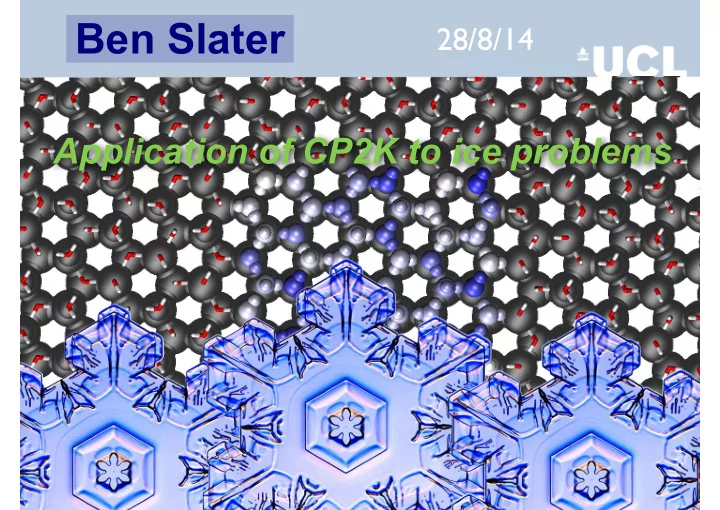

Ben Slater 28/8/14 Application of CP2K to ice problems
Ice phase diagram 15 known crystalline ice phases Several amorphous forms (e.g. see Martonak et al. JCP 2005 ) Many phases are order/ disorder pairs e.g. Ih/XI, V/ XIII, VII/VIII XII found in 1998, 3 further phases reported 2006-2009
Why ice is like an old mattress = M. Watkins, D. Pan, A. Michaelides, J. VandeVondele, B. Slater, Nature Materials , 10 , 794 2011
Vacancies in ice ! Bulk vacancy energy constant 0.74eV±0.025eV Surface vacancy energy varies by ~0.8eV and ~0.5eV in outermost layer
Dipoles in perfect ice ! LDA Dipole variance is an intrinsic property of crystalline ice proton disordered phases
Dipole moment correlated with vacancy energy
Why does this variance arise? As part of this study, ADMM was used to compute PBE0 dipole moments on 288 molecule cells with an overhead 100% w.r.t PBE • Each molecular dipole sits in a frustrated lattice exhibiting orientational disorder • In the bulk, due to proton disorder and the symmetry of oxygen network, the molecule feels an average field • At the surface, the symmetry is lowered and local environment has a strong influence on the local ESP • Generic property - e.g. spin ice, hydrates
Consequences Displacement reaction • Around 10% of surface sites are comparatively very weakly bound • At low temperature admolecules formed (proto-QLL) • All vacancy energies lowered upon vacancy-admolecule formation • Influence on pre-melting and reaction chemistry
The ice XV problem see The polymorphism of ice: five unresolved questions, Salzmann et al., PCCP, 2011 Ice XV/VI have the largest variation in hydrogen bond angle of any phase. Problem solved?
Key ice XV structures 2C1 9A2
Accuracy of CP2K PBE Largest discrepancy 0.06 kJ/mol GPW approach very comparable with full PW
Hybrid and vdW? PBE Varying HF and vdW does not change the order of stability
RI-MP2 &XC &XC_FUNCTIONAL NONE &SUBSYS &END XC_FUNCTIONAL &CELL &HF ABC [angstrom] 4.388266 7.634326 7.182104 FRACTION 1.0 MULTIPLE_UNIT_CELL 3 2 2 &SCREENING &END CELL EPS_SCHWARZ 1.0E-8 &TOPOLOGY SCREEN_ON_INITIAL_P FALSE COORD_FILE_NAME hex.xyz &END SCREENING COORD_FILE_FORMAT XYZ &INTERACTION_POTENTIAL MULTIPLE_UNIT_CELL 3 2 2 POTENTIAL_TYPE TRUNCATED &END TOPOLOGY CUTOFF_RADIUS 6.55 &KIND H T_C_G_DATA t_c_g.dat BASIS_SET cc-TZ &END RI_AUX_BASIS_SET RI_TZ &MEMORY POTENTIAL GTH-HF-q1 MAX_MEMORY 1800 &END KIND &END O(N 5 ) &KIND O &END HF BASIS_SET cc-TZ &WF_CORRELATION RI_AUX_BASIS_SET RI_TZ METHOD RI_MP2_GPW &WFC_GPW POTENTIAL GTH-HF-q6 CUTOFF 300 &END KIND REL_CUTOFF 50 &END SUBSYS EPS_FILTER 1.0E-12 EPS_GRID 1.0E-8 &END 96 molecules MEMORY 1800 NUMBER_PROC 24 &END 1078s on 3840 processors (Archer) &END XC
RI-MP2 results 2048 hybrid nodes: NVIDIA-Tesla-K20X graphical processing unit and 8 Intel-Xeon-E5 processors. 2048 GPUs, 16384 CPUs (organized as 4096x4 MPIxOMP). On average the full cell optimization is converged in 20 steps. Average Timing per step: 390 s, Average Timing per step, RI-MP2 part: 320 s Full cell optimisation! 9A2 = Cc most stable Theory still predicts exptl (2C1) structure to be metastable
dRPA results O(N 4 ) Basis Functions Machine Timing (s) Primary Auxiliary Num Hyb Nodes RI-MP2 RI-dRPA cc-TZ 4560 10880 1024 279.1 216.9 cc-QZ 9120 19040 2048 523.8 347.6 cc-5Z 16000 29600 4096 - 1165.4
A possible new ice I phase? Hexagonal Cubic • Work esp. by Ben J. Murray et al. (Leeds) (e.g. Nature , 2005) has highlighted the potential importance of cubic ice • How trustworthy are potential models for modelling cubic ice and nucleation? (cubic ice typically formed in brute force crystallisation studies despite being metastable w.r.t hexgonal ice) • Assess proton ordering to establish any intrinsic bias (using DFT as a benchmark)
Comparing Ih and Ic XIh XIc 2 clear favoured configurations
A possible new ice phase? XIh XIc Structures are isoenergetic XIc a possible competing phase? Z Raza et al., PCCP, 2011
Ice XIh/XIc revisited PBE MP2 RPA -1655.6800 -1650.7900 -1663.760 -1655.6925 -1650.8025 -1663.775 ~40J/mol ~60J/mol -1655.7050 -1650.8150 -1663.790 Expt 30-50J/mol Outlier 150J/mol -1655.7175 -1650.8275 -1663.805 -1655.7300 -1650.8400 -1663.820 -1 -0.5 0 0.5 1.0 / GPa -1.0 -0.5 0 0.5 1.0 / GPa -1.0 -0.5 0 0.5 1.0 / GPa XIh has an extra molecule in the second coordination shell - vdW stabilised Mauro del Ben, Joost VandeVondele, BS, Christoph Salzmann unpublished results
Acknowledgements Mauro del Ben, U Zurich Joost VandeVondele, ETH Zurich Christoph Salzmann, UCL EPSRC
Recommend
More recommend